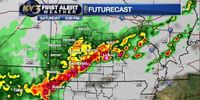Across the western and central United States, the middle of October 2025 has brought a dramatic turn in weather, with historic storms and wild swings in temperature making headlines from Nevada’s mountains to the Ozark Plateau. Meteorologists and climatologists are pointing to both immediate atmospheric patterns and longer-term climate trends as explanations for this recent bout of extreme weather.
In Nevada, the recent storm that swept through the region has been described as nothing short of historic. According to KOLO, Nevada State Climatologist Baker Perry confirmed, "It actually ranks third. And so there’s a lot of water in the snow up there. It’s a great start to the year." This storm, which hit in the first half of October, is now officially one of the top three largest for the month since 1981, a remarkable statistic for a region that often depends on early snowpack to set the tone for its water year.
Perry explained that the underlying cause of such an intense storm is linked to a warming climate. "As the atmosphere warms and especially as the Pacific Ocean warms, there’s more moisture to work with,” he told KOLO. This increased atmospheric moisture can lead to a variety of outcomes: sometimes, it results in more rain over extended periods, while in other cases, it can create storm systems that park themselves over a single area, dumping heavy rainfall or snow depending on the elevation. The upshot? As Perry put it, "That threat or that likelihood of heavier precipitation is going to continue to increase as the atmosphere warms."
This isn’t just a one-off event, either. The Truckee Meadows region, which includes Reno and its surrounding valleys, is currently experiencing a weak La Niña, according to Perry. This climate pattern is notorious for introducing greater swings in year-to-year precipitation, making it harder for residents and officials to predict what each season will bring. And the forecast for the coming week? Perry noted, "Looking ahead towards seven, eight days out, there are indications we may have another storm system coming in, connected to a very strong jet stream crossing the Pacific. So that’s something we’ll continue to keep an eye on." For winter sports enthusiasts and water managers alike, this is welcome news—more snow means a healthier snowpack and more water stored for the dry months ahead.
Meanwhile, the central United States has been dealing with its own meteorological drama. According to KY3, the night of October 17, 2025, started off calm enough, with clear skies and balmy temperatures in the 70s—ideal for high school football games and other outdoor activities. But as the evening wore on, thunderstorms began brewing in eastern Kansas, setting the stage for a much more turbulent Saturday.
October 18 brought what meteorologists described as a "complex weather pattern" to the Ozarks, with a three-boundary front colliding with a powerful low-level jet. The result? Multiple rounds of thunderstorms that eventually merged into a sprawling area of rain, crawling slowly across the region. Severe weather was a real concern, with the primary threats being golf-ball-sized hail and strong, gusty winds. While the tornado risk was described as low, it was by no means zero, keeping residents and local authorities on high alert.
The severe weather was expected to subside by early evening—between 5 and 6 p.m.—but rain was forecast to linger well into Saturday night, especially east of Highway 5. Temperatures on October 18 varied dramatically, with the upper 60s in areas soaked by prolonged rain and the upper 70s in drier spots like West Plains and Jasper, Arkansas.
As quickly as the storms arrived, a new weather pattern was set to take hold. On October 19, strong, cold northwest winds were expected to sweep through the region, ushering in a marked change of seasons. Highs would drop to the mid-60s, but the sun would return in full force, offering a brief respite from the previous day’s chaos. The rollercoaster would continue into Monday, October 20, as very strong southwest winds were predicted to bring rapid warming—morning temperatures would start in the mid-40s, but highs would climb back to around 75 degrees.
But the weather’s wild ride wasn’t over yet. By Tuesday, October 21, another cold front was forecast to move through the Ozarks, bringing cooler air but no rain. Wednesday would be quiet and sunny, with highs in the upper 60s. However, forecasters were keeping an eye on yet another storm system, this one currently swirling off the California coast. If it tracked eastward as expected, it could deliver another round of rain to the Ozarks by Thursday and Friday, October 23 and 24, keeping temperatures in the low to mid-60s.
Looking at these events side-by-side, a few key themes emerge. First, the variability and intensity of storms are becoming more pronounced, a trend that experts like Perry attribute to climate change. The warming of both the atmosphere and the Pacific Ocean is making it easier for storms to gather and dump large quantities of moisture, whether as rain or snow. This doesn’t mean every storm will break records, but the odds of extreme events are rising.
Second, the interplay between large-scale climate patterns—like La Niña—and immediate weather drivers—like jet streams and frontal boundaries—makes forecasting more challenging. In Nevada, the combination of a weak La Niña and a strong Pacific jet stream is setting the stage for more storms in the coming weeks. In the Ozarks, the dance between cold fronts and warm winds is producing rapid shifts between unseasonably warm and chilly days, punctuated by bouts of severe weather.
For residents, these patterns can be both a blessing and a curse. On one hand, early and abundant snowfall in Nevada is a boon for water supplies and recreation. On the other, the threat of severe storms, hail, and even tornadoes in the Ozarks can disrupt daily life and pose real dangers. As Perry observed, "It’s certainly a good start to the water year, and good to have snow on the mountains and some moisture in the soil too with the rainfall at lower elevations."
With more storms potentially on the horizon and climate variability on the rise, communities across the West and Midwest are learning to expect the unexpected. The only certainty, it seems, is that the weather will keep everyone guessing.




